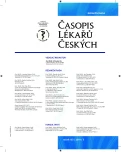Good death: Euthanasia in the eyes of medical students
Authors:
Josef Kuře; Michaela Vaňharová
Authors‘ workplace:
Ústav lékařské etiky, Masarykova univerzita, Brno
Published in:
Čas. Lék. čes. 2014; 153: 146-153
Category:
Original Article
Overview
Both in the general public and in the professional communities, very diverse notions of euthanasia can be found. At the same time determining of the precise semantics of euthanasia is one of the crucial prerequisites for subsequent meaningful ethical discussion of euthanasia. The paper analyzes an empirical study investigating the understanding of euthanasia by medical students. The aim of the conducted research was to identify the semantic definitions of euthanasia used by the first-year medical students.
Keywords:
euthanasia – death – thanatology – killing
Sources
1. Heidegger M. Sein und Zeit. Tübingen: Niemeyer 2006; 231–266.
2. Cohen-Almagor R. The right to die with dignity: an argument in ethics, medicine, and law. New Brunswick, NJ: Rutgers University Press 2001.
3. Graefe S. Autonomie am Lebensende? Biopolitik, Ökonomisierung und die Debatte um Sterbehilfe. Frankfurt am Main, New York: Campus 2007.
4. Karlsson M, Milberg A, Strang P. Dying cancer patients’ own opinions on euthanasia: An expression of autonomy? A qualitative study. Palliative Medicine 2012; 1: 34–42.
5. Lewy G. Assisted death in Europe and America. Oxford, New York: Oxford University Press 2011.
6. Ball H. At liberty to die: The battle for death with dignity in America. New York: New York University Press 2012.
7. Bauman Z. Úvahy o postmoderní době. Praha: Slon 2006; 61–93.
8. Keyserlingk E. Euthanasiegesellschaften. In: Eser A, Lutterotti M, Sporken P (eds.) Lexikon Medizin, Ethik, Recht. Freiburg, Basel, Wien: Herder 1992; 322–330.
9. Kuře J. Good death within its historical context and as a contemporary challenge: A philosophical clarification of the concept of „euthanasia“. In: Kuře J (ed.) Euthanasia – The „good death“ controversy in humans and animals. Rijeka: InTech 2012; 3–44.
10. Walton D. Active and passive euthanasia. Ethics 1976; 86: 343–349.
11. Rachels J. Active and passive euthanasia. In: Kuhse H, Singer P (eds.) Bioethics. An anthology. Oxford: Blackwell 1999; 227–230.
12. Warnock M, Macdonald E. Easeful death. Is there a case for assisted dying? Oxford, New York: Oxford University Press 2009; 15–20.
13. Callahan D. Killing and allowing to die. In: Mappes TA, DeGrazia D (eds.) Biomedical ethics. Fourth edition. New York: McGraw-Hill 1997; 388–390.
14. Haškovcová H. Thanatologie. Nauka o umírání a smrti. Praha: Galén 2000; 104–106.
15. Luper S. The philosophy of death. Cambridge, New York: Cambridge University Press 2009; 171–196.
16. Strobachová I. Konečně o eutanázii na půdě filosofie. Filosofický časopis 2011; 3: 421–425.
17. Hříbek T. Ještě o etice eutanázie. Filosofický časopis 2011; 5: 911–931.
18. Hříbek T. Utilitarismus, nacismus a eutanázie. Filosofický časopis 2012; 6: 899–908.
19. Draper H. Euthanasia. In: Chadwick R (ed). Encyclopedia of applied ethics. San Diego, London: Academic Press 1998; vol. II, 175–187.
20. Kuhse H. Euthanasia. In: Kuhse H, Singer P (eds.) A companion to ethics. Oxford: Blackwell 1997; 294–302.
21. Battin MP. Euthanasia and physician-assisted suicide. In: Lafollette H (ed.). The Oxford handbook of practical ethics. Oxford: Oxford University Press 2003; 673–704.
22. Brock DW. Voluntary active euthanasia. In: Beauchamp TL, Walters L (eds.) Contemporary issues in bioethics. Sixth edition. Belmont …: Thomson 2003; 216–225.
23. Campbell A, Gillett G, Jones G. Medical ethics. Fourth edition. Oxford: Oxford University Press 2005; 205–220.
24. Kuře J. Dobrá smrt. K filozofickému ujasnění pojmu eutanázie. Filozofia 2007; 62: 223–234.
25. Beauchamp TL. Euthanasia and assisted suicide. In: Beauchamp TL, Walters L (eds.) Contemporary issues in bioethics. Fifth edition. Belmont …: Thomson 1999; 271–275.
26. Shannon TA, Faso CN. Let them go free: A guide to withdrawing life support. Washington, DC: Georgetown University Press 2007.
27. Jox RJ. Sterben lassen. Über Entscheidungen am Ende des Lebens. Hamburg: Körber-Stiftung 2011.
28. Quill TE. Death and dignity. N Engl J Med 1991; 324: 691–694.
29. Wreen M. The definition of euthanasia. Philosophy and Phenomeno-logical Research 1988; 48: 637–653.
30. Brock DW. Death and dying. In: Veatch RM (ed.) Biomedical ethics. Second edition. Boston, Toronto, London, Singapore: Jones and Bartlett 1997; 363–394.
31. Kohl M. Euthanasia. In: Becker LC, Becker CB (eds). Encyclopedia of ethics. Second edition. New York, London: Routledge 2001; vol. I, 492–498.
32. Beauchamp TL. End-of-life decision making. In: Beauchamp TL, Walters L (eds). Contemporary issues in bioethics. Sixth edition. Belmont …: Thomson 2003; 179–185.
33. Dworkin R. Physician-assisted death. In: Steinbock B (ed.) The Oxford handbook of bioethics. Oxford: Oxford University Press 2007; 375–392.
34. Kamm FM. Ending life. In: Rhodes R, Francis LP, Silvers A (eds.) The Blackwell guide to medical ethics. Oxford: Blackwell 2007; 142–161.
35. Otlowski MFA. Voluntary euthanasia and the Common Law. Oxford: Clarendon Press 1997.
36. Heide van der A, Delden van JM, Wal van der G. Doctor-assisted dying: What difference does legalisation make? The Lancet 2004; 364: 24–25.
Labels
Addictology Allergology and clinical immunology Angiology Audiology Clinical biochemistry Dermatology & STDs Paediatric gastroenterology Paediatric surgery Paediatric cardiology Paediatric neurology Paediatric ENT Paediatric psychiatry Paediatric rheumatology Diabetology Pharmacy Vascular surgery Pain management Dental HygienistArticle was published in
Journal of Czech Physicians

Most read in this issue
- Resisance to thyroid hormones
- Good death: Euthanasia in the eyes of medical students
- Contemporary possibilities of non-oral estrogen-progestin contraception
- Contemporary options and perspectives in the treatment of acromegaly
